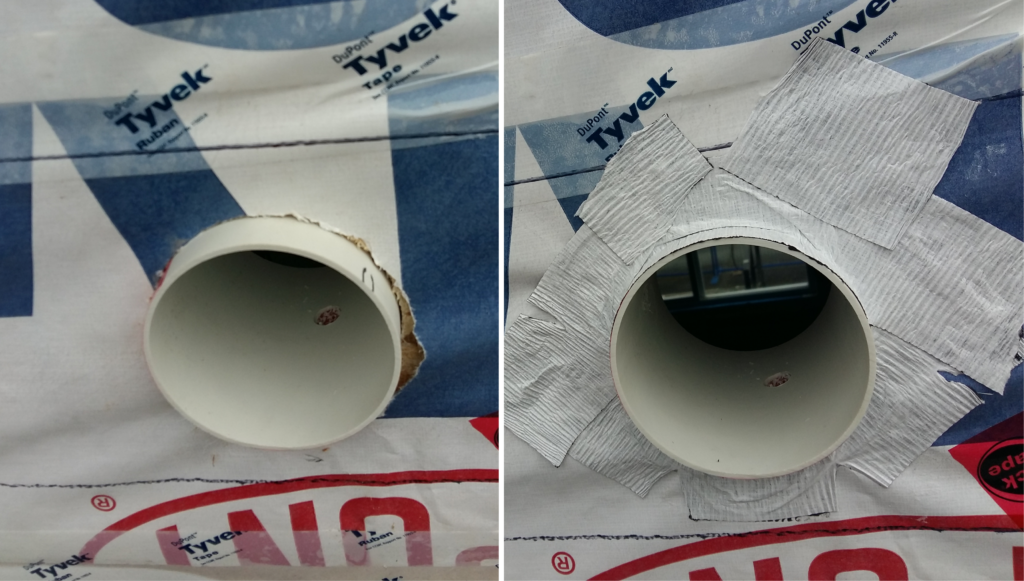It’s a misconception we hear again and again. “Well it’s 10% of the size of an average house, so it’s what, 15% of the construction work?”
People assume that the small footprint of their Tiny House build logically means it’s proportionally less work. This was made very apparent today while working on planning for the exterior of a new unit. Coming in at a whopping 18 square meters (~200 square feet), the home we were building had THIRTEEN different building envelope penetrations. For the layperson, a building penetration is any place where something (vent, pipe, wire etc) penetrates the waterproof Tyvek building envelope on the outside of a home, under the wall cladding (siding).

If you’re not one well versed in building envelope and waterproofing, think of it this way. Imagine you’re going to build a boat. You want that boat to be waterproof right? That’s the same for your home, you want water from rain, melting snow or garden hoses to stay outside. Now think of a boat hull. They’re usually made of one single piece of fibreglass with as few holes as possible. You might have one hole for the propeller shaft to stick out of, maybe another for a bilge pump and so on. If you’re going to have a leak, it’s going to be from one of those places so you put extra work into making sure they’re extra watertight. If you could, you’d have ZERO hull penetrations and you’d have way less problems with leaks. Now think of your house. If you wrapped it in large, unbroken sheets of building wrap (Tyvek), you’d have way less chance of a leak. But you need to get water, power and propane into your Tiny House, so you need to punch holes in that waterproof wrap. You also need to get moist air out, maybe propane out to a BBQ connection, electricity out to an external power receptacle and maybe an external hose bib. Each and every one of those penetrations takes WAY more time and effort than an unbroken stretch of wall. You have to use special tape to seal the pipe or wire to the building wrap, you need to put a rain flashing over the connection, trim around the penetration and just THINK more!
So no matter how you work it, more penetrations = more work
An average sized house might have 3 times as many penetrations but they’re spread over 5 times as much exterior wall. So as your building shrinks, the amount of work per linear meter of exterior wall increases. Now add to that the fact that the closer together things get, the more work they become, as you have less and less space to locate things. Clearly, while smaller is less work IN TOTAL, it’s certainly not proportionally less work. For a Tiny House, you end up spending way more time doing your exterior trim and flashings than you do putting the actual siding on.
Now, all is not lost. Here are some things you can do at the planning phase that can save you time and money and simplify your build:
- Cluster your penetrations: Rather than a separate plate and flashing for each penetration, group them together on a single trim plate, with a single flashing. This is also beneficial because if there IS a problem in the future, you minimize disassembly for repair. You can also butt mounting plates against door/window trim to save small siding cuts.
- Move penetrations underneath: Need an external receptacle to run your garden lights? If it’s mounted in the underbody of your house, it’s protected from water and doesn’t need to be trimmed or flashed and leaves your walls clean and simple. You can also mount a receptacle in your protected soffit if your Tiny has it.
- Rethink your penetrations: Do you really need them all? Yes an external BBQ connection is nice, but if your propane tanks are 8ft away, can you simply run a flex hose under the building? You can do the same for a hose bib. Can you run power from the pedestal where you plug your home’s power cord in? Do you need a plug on EVERY wall of your house?
At the drawing phase, saying “Oh I want a plug there” is easy but most people don’t realize that when it’s all said and done, the plug can work out to be hundreds of dollars in added work and materials. Keep it simple, save your money!
